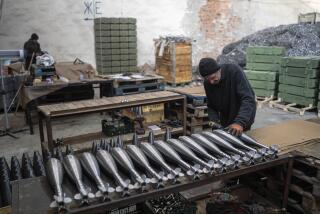‘Peace Dividend’ Holds a Challenge
Most predictions about the “peace dividend” are wrong. They see post-Cold War reductions in the defense budget as a national windfall, paying for everything from environmental cleanup to traffic lights at school crossings.
But peace is not a bonanza, it’s a challenge: to find productive work for the skills and know-how of the people and companies involved in U.S. defense. That’s a lot of people--2 million in uniform, an additional 1 million civilian employees of the Defense Department and roughly 1 million employees in the aerospace-defense industry.
The challenge is urgent. Reductions already agreed to in the $291-billion defense budget mean the loss of 250,000 defense jobs in the next two years, with 500,000 more discharged from the armed forces and an undetermined number let go from the Pentagon.
And actual cuts will be deeper. Those estimates were made after the fall of the Berlin Wall but before the demolition of Lenin’s Tomb.
The danger is that skills and technology accumulated at great public expense over four decades--in aerodynamics, optics, fluid mechanics, composite materials, systems integration--will seep away as the defense industry downsizes. “Technology is like hydrogen gas,” says one expert, “if you don’t keep making more, it evaporates.”
But there’s a promise in defense reductions, too--that skills developed in military work will spread throughout U.S. industry, upgrading today’s products and processes and launching a new era of innovation.
And chances are the bright promise, or most of it, will come true--even though it seems a long shot at present.
The stock market is writing off the future of defense, valuing major defense companies such as Martin Marietta, Lockheed and Raytheon at only eight times earnings, while pricing the average stock at 17 times earnings. Even Rockwell International, which gets more than half its revenues from civilian business, is valued 35% below the average big company.
The market’s judgment is that defense firms will have difficulty adapting to civilian life; that working as they do to serve the military and the U.S. Congress means they are driven by performance and politics rather than costs and pricing--the concerns of commercial customers.
That’s why their attempts at diversification so often come to grief. United Technologies blew a bundle in semiconductors, Rohr and Grumman struck out with ventures in subway cars and buses and Martin Marietta was disappointed in satellite communications. As Martin Marietta Chairman Norman Augustine observes, it’s a record “unblemished by success.”
How will that pattern change in future, how can the promise in defense reductions be realized? In ways not narrowly predictable--as companies look for business outside defense and employees use their skills in other fields.
For example, Richard MacNeal, founder and chairman of MacNeal-Schwendler Corp.--developer of the world’s leading computer program for stress-testing airplanes-- sees fresh growth in adapting another of his company’s programs to analyzing magnetic fields in microwave ovens.
Employees used to working with rocket engines may apply their knowledge to power generation; engineers used to plotting missile guidance, may switch to highway safety or medical electronics. Martin Marietta’s Augustine says there’s a natural opening for engineers to teach math and science.
Multinational industry needs those in and out of uniform who have worked with systems integration--the computerized coordination of suppliers in a major project. Military industry has gone furthest in this art of “paperless management.”
Still, the transition won’t be effortless. Defense companies and employees are accustomed to turning out a few specialized products, to specifications from Washington. Commercial industry deals in a multitude of standard products and demands individual initiative to find customers.
Government can help with the transition, but mainly by creating an encouraging environment, through tax laws and other supports.
The real key will be “leadership,” says Wolfgang Demisch, aerospace analyst for UBS Securities. “This industry needs a Charles Lazarus or a Sam Walton (the chairmen, respectively, of Toys R Us and Wal-Mart), managers with service and cost-consciousness in their blood, and if they see bureaucracy, instinctively they shoot it.”
Yes, but what would attract such people to the defense industry? The values and the price. Trained people can be hired at reasonable salaries, technology is available for a song at current stock market prices. Watch for acquisitions and joint ventures involving non-defense companies and for new companies being split off from military contractor parents.
It has happened before. Defense firms merged and changed in an earlier shakeout, in the late 1960s--as Vietnam War procurement declined. That was when TRW diversified into the credit information business and North American Aviation merged into Rockwell, then a Pittsburgh-based axle maker. Within a few years a great surge of innovation occurred, not mainly in defense but in electronics--Silicon Valley was born.
That was no coincidence. Peace is productive, if we work at the transition.
More to Read
Sign up for Essential California
The most important California stories and recommendations in your inbox every morning.
You may occasionally receive promotional content from the Los Angeles Times.










